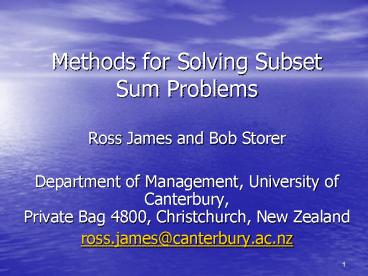Methods for Solving Subset Sum Problems - PowerPoint PPT Presentation
1 / 27
Title:
Methods for Solving Subset Sum Problems
Description:
Department of Management, University of Canterbury, Private Bag 4800, Christchurch, New Zealand ... For this application we introduce a 'tolerance' level ... – PowerPoint PPT presentation
Number of Views:1029
Avg rating:3.0/5.0
Title: Methods for Solving Subset Sum Problems
1
Methods for Solving Subset Sum Problems
- Ross James and Bob Storer
- Department of Management, University of
Canterbury,Private Bag 4800, Christchurch, New
Zealand - ross.james_at_canterbury.ac.nz
2
Combination Weighers
3
The Subset Sum Problem
- Minimise
- Subject to
- where wi is the weight of product in bucket i.
4
Small Problem Results
- For this application we introduce a tolerance
level whereby if we find a feasible solution that
has - we use this solution and do not explore any
further.
5
Number Partitioning
- Splits a set of numbers in two in order to
minimise the difference in the sums of the two
sets - Special case of Subset Sum, where the requirement
is ½ the total weight - Number Partitioning Problems can be converted to
Subset Sum problems by adding a dummy item. - Care in terms of Subset Sum being one-sided
6
Number Partitioning
- Karmarker and Karp (1982) proposed a very
efficient differencing heuristic for solving
number partitioning problems - Korf (1998) incorporated this into a branch and
bound framework
7
Example
- Want to get a minimum of 50
- Add Dummy item of weight 8
8
Example Continued
9
Example Continued
10
Example Continued
11
Solution Techniques
- Seeded Complete Karmarkar Karp (SCKK)
- Enumeration
- Direct Search
- Heuristic Direct search
12
SCKK Technique
- Starts with the KK solution which has been
modified to ensure feasibility - From the Feasible starting solution the BB Tree
is created - BB Depth First Search continues from this point
13
SCKK Example
14
Enumeration
- Starts with a feasible solution
- Sorts Taken and Non-Taken items in Non-decreasing
weight order - Recursively examines all solutions
- Drops and adds items in no decreasing order
- Allows large sections of the solution space to be
ignored
15
Enumeration Example
- Start with 5,3,1 as taken, 4, 2 as not taken,
Best Value 57 - Drop 5, add 4, Value 58. Solution Bounded
- Drop 3, add 4, Value 54. Solution Bounded
- Drop 1, add 4, Value 47, Infeasible so Add 2 as
well, Value 67 - Drop 1, add 2, Value 52
16
Direct Search
- Based on the premise of quickly fine tuning a
good solution - Based on initially keeping number of items taken
the same. - The number of items taken changes once all
possibilities have been tried - Items are sorted in ascending order to speed up
execution - All moves involving 1 item are tried first, then
2 etc.
17
Direct Search Example
Moving a Single Item
18
Direct Search Example
Moving Two Items
19
Heuristic Direct Search
- Uses the same Direct Search framework but only
considers swapping 1 item before making a move. - Does not guarantee that the optimal will be
found, so needs a termination condition
20
Computational Experiments
- All algorithms coded in MS Visual C
- Run on Windows XP, 1.53GHz AMD Athol XP
Processor, 1 Gab Ram
21
Small Problems
- 50 Randomly generated problems
- 32 Containers
- Requirements of 8, 10, 16
- Both normal (mean of 1, std dev of 0.1, 0.2, 0.3)
and uniform (0.7,1.3, 0.4,1.6,0.1,1.9)
weight distributions tested - Tolerance of 10-8
22
Small Problem Results
- Direct Search did not perform at all well on
small problems - CKK performed well for requirements of 16 which
is closes to the number partitioning situation - Enumeration was the fastest method when the
requirements were 8 or 10
23
Small Problem Results
- CKK and SCKK slowed down considerably when the
requirement was 10. - Enumeration liked smaller variances in the data,
whereas CKK and SCKK generally performed better
with more variance - CKK outperforms SCKK for these problems
- Enumeration performs better on Normal data while
CKK/SCKK performs better on Uniform data
24
Large Problems
- 30 randomly generated problems of 200 items
- Requirements were 100 and 50
- Normally distributed data, with same mean and
standard deviations as the small problems - Tolerance of 10-8
25
Large Problem Results
26
Large Problems Results
- CKK could not be run due to excessive time
requirements - SCKK could not be run on when the data standard
deviation was 0.1 and requirement was 50 - Direct Search and Heuristic Direct Search were
clearly superior, with solutions times an order
of magnitude smaller than the SCKK
27
Questions
- ?































